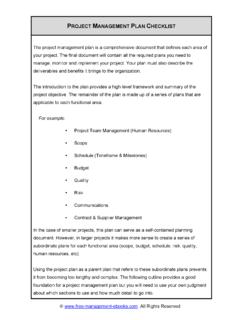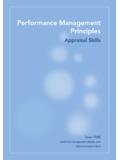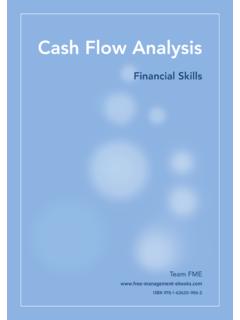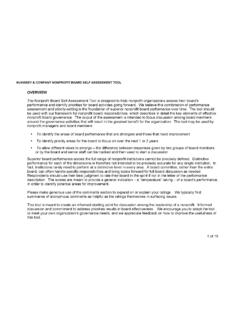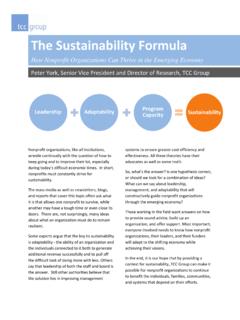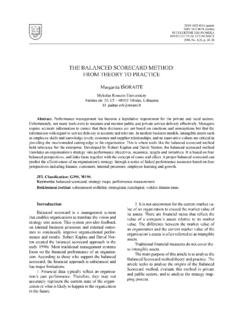Transcription of Accounting Principles - Free Management eBooks
1 Team FMEF inancial SkillsAccounting 978-1-62620-953-4 Copyright Notice 2013. All Rights ReservedISBN 978-1-62620-953-4 The material contained within this electronic publication is protected under International and Federal Copyright Laws and treaties, and as such any unauthorized reprint or use of this material is strictly may not copy, forward, or transfer this publication or any part of it, whether in elec-tronic or printed form, to another person, or or translation of any part of this work without the permission of the copy-right holder is against the downloading and use of this eBook requires, and is an indication of, your complete acceptance of these Terms of Use. You do not have any right to resell or give away part,or the whole, of this 978-1-62620-953-4 1 Accounting PrinciPleStable of contentsPreface 2 Visit Our Website 3 Introduction 4 Basic Accounting Concepts 6An Income Statement 6A Sample Simple Income Statement 7 Cash Accounting 9 The Limitations of Cash Accounting 11 Accrual Accounting 15 Basic Financial Terms 16 The Revenue Recognition Principle 19 The Matching Principle 22A Sample Income Statement Using the Accrual Method 23 Summary 28 Other Free Resources 29 References 30 ISBN 978-1-62620-953-4 2 Accounting PrinciPleSPrefaceThis eBook explains all of the basic Accounting concepts and terminology you will need to understand the three primary financial statements that appear in every organization s annual report and most internal monthly reports.
2 You will learn: The precise definition of essential Accounting terms The purpose of the income statement, balance sheet, and cash flow statement The differences between cash-based and accrual-based Accounting The revenue recognition principle and the matching principle How depreciation, prepayments, and bad debt are allowed forISBN 978-1-62620-953-4 3 Accounting PrinciPleSVisit our WebsiteMore free Management eBooks along with a series of essential templates and check-lists for managers are all available to download free of charge to your computer, iPad, or Amazon are adding new titles every month, so don t forget to check our website regularly for the latest ISBN 978-1-62620-953-4 4 Accounting PrinciPleSintroductionAs a manager, you may be asked to produce or contribute towards an income statement for your own business unit. This provides senior Management with an indication of how your business unit is performing against its targets over a specific period, for example quarterly.
3 In addition, you will usually be expected to understand simple financial reports and communicate effectively with financial people in your own eBook explains all of the basic Accounting concepts and terminology you will need to understand the three primary financial statements that appear in every organization s annual report and most internal monthly reports as well. Income StatementBalance SheetStatement of Cash FlowPrimary Financial Statements are:These are: The Income Statement An Accounting of revenue, expenses, and profit for a given period. This can also be an internal document that can be used to make Management decisions about almost any activity where you have a record of the money spent and the associated return. The Balance Sheet An itemized statement that summarizes the assets and li-abilities of the business at a given date. The Statement of Cash Flow A report that shows the effect of all transactions that involved or influenced cash but did not appear on the income you work in a nonprofit sector then do not be put off by words like business and profit.
4 Even if your organization is not a business that exists to make a profit, it is still important to understand the basic Principles of finance and Management reporting so that you can monitor efficiency and control your budget effectively. ISBN 978-1-62620-953-4 5 Accounting PrinciPleSNonprofi t organizations need to managetheir fi nancial expenditure and do so using business terminologyYour organization may not be concerned with sales and profit as such, but there will be some metrics for measuring the service delivered and the costs incurred in delivering it. Financial reporting requires an understanding of: basic financial terms, the differences between cash-based and accrual Accounting , and an appreciation of when revenue and costs are recognized. All of these topics are dealt with in this eBook, which is an ideal introduction to basic Accounting POINT 4 You should make sure that you know the basic concepts and terminology needed to understand income statements, balance sheets, and statements of cash flow as these are widely used, even by nonprofit 978-1-62620-953-4 6 Accounting PrinciPleSBasic Accounting concepts The basic Principles of Accounting are best understood by considering some simple busi-nesses and how they might document their financial Income StatementThis is a financial statement that measures an organization s financial performance over a specific Accounting period by giving a summary of how it incurs its revenues and ex-penses.
5 It also shows the net profit or loss incurred over that period and is often referred to as a Profit and Loss or Revenue and Expenses statement. Income StatementOperating Revenue & ExpensesNon-Operating Revenue & ExpensesAn income statement consists of two sections: operating and non-operating activities. The operating section details the revenue and expenses directly associated with business operations, for example the purchase of raw materials. The non-operating section details revenue and expenses that result from activi-ties outside of normal business operations, for example the sale of an office or land. This division of revenue and expenses into operating and non-operating is particular to each organization and is dealt with in detail in the eBook Understanding Income State-ments, which you can download from For the moment we will use a simple income statement to illustrate the financial prin-ciples you need to be familiar with, since this type of income statement does not distin-guish between operating and non-operating revenues and 978-1-62620-953-4 7 Accounting PrinciPleSA Sample Simple Income StatementThis sample simple income statement covers a twelve-month period for Suzy s Signs, a one-person business that designs signage.
6 It details the amount of revenue and expense that comes in and goes out of the organization without distinguishing between operating and non-operating items. Income Statement terms:RevenueExpensesNet IncomeThe income statement uses three terms that can be defined as: Revenue incoming assets in return for sold goods or services. Expenses outgoing assets or liabilities incurred. Net Income the difference between Revenue and Expenses. This shows wheth-er you are generating a profit or you are operating at a loss. In our example, Suzy runs her own design agency called Suzy s Signs. She works from her home office and offers a design service for customers who need a sign for their business premises. The design is done according to a brief supplied by the customer. Once the design has been approved, Suzy obtains quotes for its manufacture from three suppliers. She then sends the design and the quotes to the customer including her in-voice for the total number of hours spent on this design, based on an hourly rate of $ 978-1-62620-953-4 8 Accounting PrinciPleSThe following table gives you an example of what a simple income statement would look like for Suzy Sign s.
7 Suzy s Signs Income Statement Jan 1 Dec 31$$Revenue (Design)8,000 Less Expenses:Tr a v e l420 Stationery140 Telephone80 Broadband120 Miscellaneous25 Expenses Total785 Net Profit Before Tax7,215 The net profit or loss is the difference between the income received and all of the costs paid out. In this case Suzy has made a profit for the year of $7, income receivedNet Profi t or LossAll costs paid outShe may need this information to give to the tax authorities or she could use it to com-pare this year s performance to last year s, or even to her expectations at the beginning of the simple as this document is, there are some practical issues that it raises. For example:Suzy sends out an invoice in December, but it has not been paid by 31 does she do? Should the invoice amount appear on the statement or not, and does it matter?ISBN 978-1-62620-953-4 9 Accounting PrinciPleSThe answer to this question depends on the type of Accounting that Suzy is using.
8 There are two types, known as cash Accounting and accrual Accounting . Types of Accounting SystemsCash AccountingAccrual AccountingThe practical implications of each type for your organization are explained in the next sections using our example of Suzy s AccountingThis is an Accounting method where receipts are recorded on the date they are received, and the expenses on the date that they are actually paid. As a small business, Suzy has the option of cash Accounting , which means that she only needs to record transactions at the point of payment. In other words when the money leaves or is paid into her bank account. Cash AccountingRecord transactions at the point of paymentOnly applicable to very small companies or tradersSo referring back to Suzy s query: If her December invoice is not paid until the following January, then she does not need to enter it on the income statement for this , if she received a bill in December (for example a phone bill) but she does not pay it until January, then that amount will not appear 978-1-62620-953-4 10 Accounting PrinciPleSAccounting rules stipulate that, with few exceptions, businesses should not use this method but should prepare their accounts on the accrual basis.
9 However, it is accept-able for very small companies to use the cash Accounting method. In Suzy s case, cash Accounting confers two advantages. 1. It reflects exactly what she has in her bank It helps her cash flow. Whilst the first point is obvious, the second point needs some November and December Suzy raised invoices for $2,500 worth of work, which she is awaiting payment for. Under the cash Accounting rules, she does not have to declare this income during the period and she will not have to pay any tax due on it until the end of the next Accounting period (the period when the money will actually be paid into her account). This is counterbalanced by the fact that she cannot include any expenses. For example, her December telephone bill cannot be included until she has actu-ally paid it, irrespective of the date on the s business has relatively low expenses and because her clients can be slow to pay, cash Accounting is probably the best option for her to use.
10 By using cash Accounting , she will only be paying tax on money she has actually received. It is also straightforward: if she uses a tax adviser, she could simply give him her checkbook and bank statements and he could calculate her tax liability from those two things POINTS 4 Under cash Accounting rules, transactions are recorded at the point of payment. 4 Very small businesses and traders can use cash Accounting . 4It reflects exactly what the business has in its bank account and can help with cash 978-1-62620-953-4 11 Accounting PrinciPleSThe Limitations of Cash AccountingIn cash-based Accounting , expenses are not recorded until they have been paid, which means that there is nowhere on the books to show unpaid bills. Nowhere to show an organization s unpaid bills No accurate historical trend is producedNo allowance is made for major purchases or asset acquisitionLimitations of Cash Accounting method:These limitations can create serious problems if the business is much more complex than Suzy s Signs.
